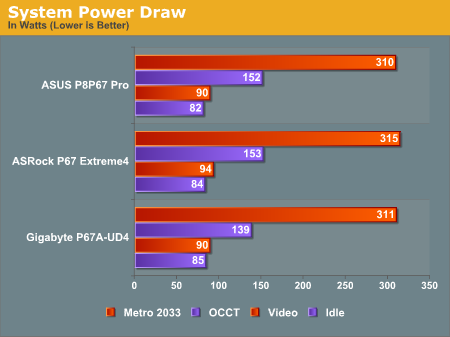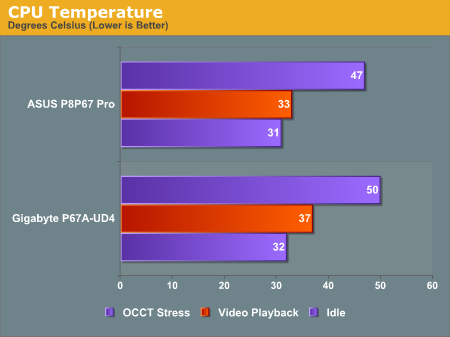The Battle of the P67 Boards - ASUS vs. Gigabyte at $190
by Ian Cutress on January 20, 2011 4:15 PM EST- Posted in
- Motherboards
- Gigabyte
- Asus
- P67
| Test Setup | |
| Processor |
Intel i5-2500K ES – 3.3 GHz (3.7 GHz Turbo) 4 Cores, 4 Threads, 6MB L3 |
| Motherboards |
ASUS P8P67 Pro Gigabyte P67A-UD4 |
| Cooling | Corsair H50-1 Water Cooler |
| Power Supply | Enermax Modu87+ 600W 80PLUS |
| Memory |
Patriot Viper Xtreme DDR3-2000 9-10-9-27 2x4GB Kit, 1.65V Patriot Viper Xtreme DDR3-2133 9-11-9-27 2x2GB Kit, 1.65V Corsair Vengeance DDR3-1600 9-9-9-24 2x4GB Kit, 1.50V |
| Memory Settings | Patriot Viper Xtreme DDR3-1333 9-9-9-24 2x2GB |
| Video Cards | XFX HD 5850 1GB |
| Video Drivers | Catalyst 10.12 |
| Hard Drive | Intel X25-M 80GB SSD Gen2 |
| Optical Drives | LG GH22NS50 |
| Case | Open Test Bed – CoolerMaster Lab V1.0 |
| Operating System | Windows 7 64-bit |
| USB 2/3 Testing | Patriot 64GB SuperSonic USB 3.0 |
Power Consumption and CPU Temperature
Power consumption was tested on the default system as a whole with a wall meter connected to the power supply, using a dual GPU configuration. This method allows us to compare the power management of the UEFI/BIOS and the board to supply components with power under load, and includes typical PSU losses due to efficiency. These are the real world values that consumers may expect from a typical system (minus the monitor) using these motherboards.


Neither system does too badly in power consumption readings, but the Gigabyte is behind on temperature deltas. This could easily be attributed to the mounting - while every attempt is made to repeat the mounting technique, there is always a range of statistical variation, so the 2-4ºC difference is nothing obvious to be concerned about.










137 Comments
View All Comments
IanCutress - Thursday, January 20, 2011 - link
Edited; simple copy/paste error. Glad you liked the review, we should have some H67 on the way next.Ian
Shadowmaster625 - Thursday, January 20, 2011 - link
May as well go down to detroit and buy a big fat rock. I would like to see you guys put together two $600 systems. One based on these outrageous $200 motherboards and a $200 cpu, and $200 for everything else. And put that up against a $70 motherboard and $200 cpu and put the extra $130 into a video card. Who in their right mind would choose this new crap? Dont even talk about encoding because encoding is something you start and then walk away. You dont need to be there to watch it encode so it dont matter how long it takes. (For 95% of users. Dont play these 5 percent mindgames.)vol7ron - Thursday, January 20, 2011 - link
I never walk away from my boxmarc1000 - Friday, January 21, 2011 - link
this is off-topic, but i think you should walk away from your box a little more. =DHrel - Thursday, January 20, 2011 - link
I agree anything over 150 for a motherboard is stupid. But these new Sandy Bridge CPU's are great! It's called progress, and when you do a lot of encoding speed does matter even if you do walk away and/or use another computer in the mean time. Not to mention how intensive encoding full 1080p content is, what about 3D and in the future 4K HD and 8K HD. It's called progress and it's a good thing!Shadowmaster625 - Monday, January 24, 2011 - link
If you do a LOT of encoding, then you will have 2, 3, or 4 machines stacked up next to each other. And those machines would have Athlon X4's and cost $200 apiece to build. Only a fool spends $200, $300, or more, on a cpu just to encode something a little bit faster. You can get much better overall throughput using cheap AMD processors from the last generation. That fact holds true whether you encode one hour a week of video, or 1000. Intel is simply hoping that people are dumber than they may or may not really be.Fatchap - Friday, January 21, 2011 - link
I used to type the command to load up a game or an application, press play on the tape player and walk away. I guess you still do the same as you would not want any of this new crap.Shadowmaster625 - Monday, January 24, 2011 - link
You are quite delusional and propagandized if you think comparing a 2600K to something like a Q6600 or X2-250 is like going from "tape players" whatever you might use now. If you want a proper comparison, try VHS vs SuperVHS. Remember that? Oh yes, you must go out and spend $300 on that shiny new super-vhs player. All your old tapes will still look the same. But that's ok because anything new you record will look pretty good. (Of course if you ever stopped and thought about it, back in the day things always looked pretty good when you first recorded them. It's not until you tried playing it back in a different vcr that it started looking bad.)When someone can build a $500 gaming system that runs faster than something with a previous generation cpu and motherboard for less money then I might begin to be interested. But when you have to go with half the stream processors just to pay for a bunch of new crap that doesnt even get you anything, it makes no sense. These chips are supposed to result in cheaper motherboards. More integration, lesss complexity, bla bla bla. Well I dont see it. I just see a money grab.
seamusmc - Friday, January 21, 2011 - link
Shadow, some of us are still a generation or two behind. We'll definitely see more then a 5 percent boost. Personally I've been waiting for this 'perfect storm' of price and performance for quite some time, though I may wait for the 22nm refresh.Sure if you have an X58 platform with a 950 it probably doesn't make sense to upgrade, certainly not for gaming. Though many of the folks that frequent this site are enthusiasts and just want to play with the new hardware regardless of cost.
seamusmc - Friday, January 21, 2011 - link
Shadow, just realized the 5 percent gain you were talking about may have been between a $70 P67 board and $200 P67 board.I'd agree on that front. Though the more expensive boards do come with more features, USB hubs, and some better quality components.